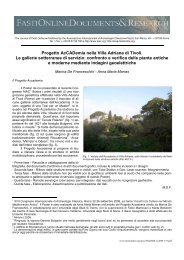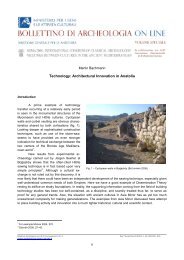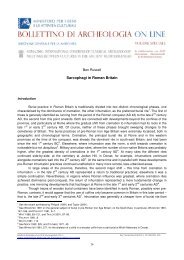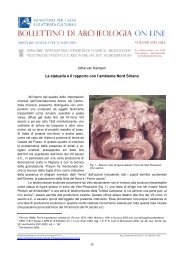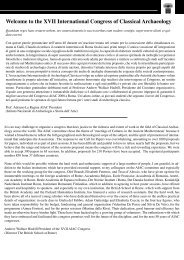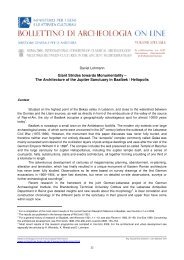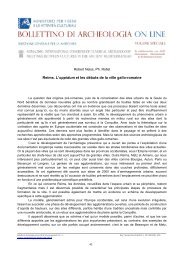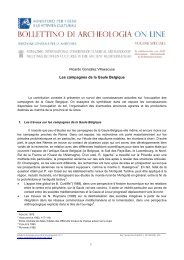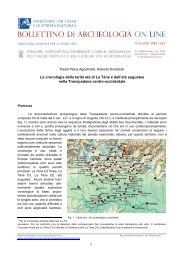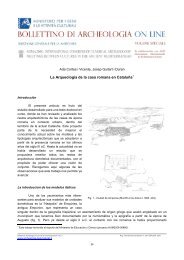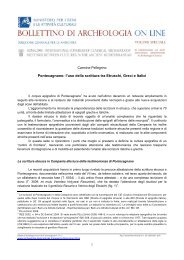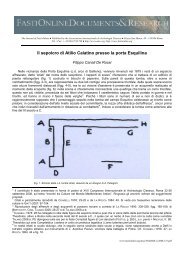Tabula Siarensis - Bollettino di archeologia on line - Ministero per i ...
Tabula Siarensis - Bollettino di archeologia on line - Ministero per i ...
Tabula Siarensis - Bollettino di archeologia on line - Ministero per i ...
Create successful ePaper yourself
Turn your PDF publications into a flip-book with our unique Google optimized e-Paper software.
BOLLETTINO DI ARCHEOLOGIA ON LINE II, 2011/2-3<br />
ad Antiochia il 10 ottobre del 19 d.C.; 10 più precisamente il senatoc<strong>on</strong>sulto <str<strong>on</strong>g>di</str<strong>on</strong>g> fine <str<strong>on</strong>g>di</str<strong>on</strong>g>cembre, il<br />
richiamo a un senatoc<strong>on</strong>sulto precedente, del 16 <str<strong>on</strong>g>di</str<strong>on</strong>g>cembre dello stesso anno, e la lex Valeria Aurelia<br />
degli inizi del 20 d.C., 11 della cui relazi<strong>on</strong>e i c<strong>on</strong>soli designati <strong>per</strong> l’anno successivo, Marco<br />
Valerio Messalla e Marco Aurelio Cotta Massimo, veng<strong>on</strong>o già incaricati dal senatoc<strong>on</strong>sulto<br />
della fine <str<strong>on</strong>g>di</str<strong>on</strong>g> <str<strong>on</strong>g>di</str<strong>on</strong>g>cembre. 12 Più precisamente, il frammento I della Tab. Siar. (che ci interessa)<br />
riporta su una col<strong>on</strong>na la fine della relatio e l’inizio della sententia relative al senatoc<strong>on</strong>sulto <str<strong>on</strong>g>di</str<strong>on</strong>g><br />
fine <str<strong>on</strong>g>di</str<strong>on</strong>g>cembre. 13 Le <str<strong>on</strong>g>di</str<strong>on</strong>g>sposizi<strong>on</strong>i del senatoc<strong>on</strong>sulto c<strong>on</strong>tinuano nel frammento II della Tab. Siar.,<br />
che c<strong>on</strong>tiene, su tre col<strong>on</strong>ne, 14 il riferimento al senatoc<strong>on</strong>sulto del 16 <str<strong>on</strong>g>di</str<strong>on</strong>g>cembre del 19 d.C., e la<br />
parte iniziale della rogatio Valeria Aurelia del 20 d.C., cioè della lex de h<strong>on</strong>oribus Germanici<br />
Caesaris.<br />
Questa legge comiziale ci è nota quasi integralmente dalla Tab. Heb., altra iscrizi<strong>on</strong>e<br />
br<strong>on</strong>zea rinvenuta nel 1947 nel territorio della col<strong>on</strong>ia romana <str<strong>on</strong>g>di</str<strong>on</strong>g> Heba, in loc. le Sassaie del<br />
comune <str<strong>on</strong>g>di</str<strong>on</strong>g> Magliano in Toscana (GR), 15 dal frammento <str<strong>on</strong>g>di</str<strong>on</strong>g> To<str<strong>on</strong>g>di</str<strong>on</strong>g> 16 e dal frammento <str<strong>on</strong>g>di</str<strong>on</strong>g> Carissa<br />
Aurelia. 17<br />
Invece, il testo del frammento CIL VI 31199a (<strong>per</strong>duto) è sovrapp<strong>on</strong>ibile al I frammento<br />
della Tab. Siar.<br />
Per maggiore chiarezza, la tabella che segue elenca le f<strong>on</strong>ti in nostro possesso riguardanti<br />
gli <strong>on</strong>ori funebri c<strong>on</strong>cessi a Germanico, raggruppandole in quattro “sessi<strong>on</strong>i”:<br />
Senatoc<strong>on</strong>sulto<br />
del 16 <str<strong>on</strong>g>di</str<strong>on</strong>g>cembre<br />
19 d.C.<br />
Tac. ann.<br />
II, 83, 1 (prob.)<br />
Tab. Siar.<br />
IIb, 11-12, 20-21<br />
(solo riferimento)<br />
10) La notizia della morte <str<strong>on</strong>g>di</str<strong>on</strong>g> Germanico arrivò a Roma circa due mesi dopo, forse pochi giorni prima dell'8 <str<strong>on</strong>g>di</str<strong>on</strong>g>cembre, giorno<br />
in<str<strong>on</strong>g>di</str<strong>on</strong>g>cato dai Fasti Ostiensi come quello dello iustitium <str<strong>on</strong>g>di</str<strong>on</strong>g> Germanico, v. GONZáLEZ 2002, p. 157 ss.<br />
11) Votata più precisamente entro l’aprile del 20 d.C., quando le ceneri <str<strong>on</strong>g>di</str<strong>on</strong>g> Germanico arrivar<strong>on</strong>o a Roma, portate dalla vedova,<br />
Agrippina.<br />
12) Nel sec<strong>on</strong>do frammento della Tab. Siar. (IIb, 23-27), il testo del senatoc<strong>on</strong>sulto <str<strong>on</strong>g>di</str<strong>on</strong>g> fine <str<strong>on</strong>g>di</str<strong>on</strong>g>cembre c<strong>on</strong>tiene l'or<str<strong>on</strong>g>di</str<strong>on</strong>g>ne del Senato<br />
<str<strong>on</strong>g>di</str<strong>on</strong>g> Roma ai c<strong>on</strong>soli del 19 d.C. <str<strong>on</strong>g>di</str<strong>on</strong>g> curarne, in margine a un loro e<str<strong>on</strong>g>di</str<strong>on</strong>g>tto, la <str<strong>on</strong>g>di</str<strong>on</strong>g>ffusi<strong>on</strong>e nei municipi e nelle province, v. GONZáLEZ<br />
2002, pp. 172 s. Lo stu<str<strong>on</strong>g>di</str<strong>on</strong>g>oso spagnolo osserva inoltre che il testo del senatoc<strong>on</strong>sulto del 16 <str<strong>on</strong>g>di</str<strong>on</strong>g>cembre fu probabilmente pubblicato<br />
in br<strong>on</strong>zo solo nel portico del tempio <str<strong>on</strong>g>di</str<strong>on</strong>g> Apollo Palatino, essendo le sue <str<strong>on</strong>g>di</str<strong>on</strong>g>sposizi<strong>on</strong>i <str<strong>on</strong>g>di</str<strong>on</strong>g> esclusiva applicazi<strong>on</strong>e romana: esso<br />
avrebbe verosimilmente c<strong>on</strong>tenuto gli <strong>on</strong>ori che interessavano solo il popolo <str<strong>on</strong>g>di</str<strong>on</strong>g> Roma, cioè quelli <str<strong>on</strong>g>di</str<strong>on</strong>g> Tac. ann. II, 83, 1, e che<br />
n<strong>on</strong> comparirebbero appunto nella Tab. Siar. (il nome <str<strong>on</strong>g>di</str<strong>on</strong>g> Germanico inserito nel carmen Saliare, la sua se<str<strong>on</strong>g>di</str<strong>on</strong>g>a curule nei posti riservati<br />
ai sacerdoti Augustali, la sua statua d'avorio in testa alla pompa circensis, e la successi<strong>on</strong>e ai suo titoli <str<strong>on</strong>g>di</str<strong>on</strong>g> augure e flamine<br />
c<strong>on</strong>cessa solo a membri della gens Iulia).<br />
13) La sententia si apre c<strong>on</strong> la de<str<strong>on</strong>g>di</str<strong>on</strong>g>ca <str<strong>on</strong>g>di</str<strong>on</strong>g> tre archi in <strong>on</strong>ore <str<strong>on</strong>g>di</str<strong>on</strong>g> Germanico, cfr. Tac. ann. II, 83, 2.<br />
14) O cinque, cfr. GONZáLEZ – FERNáNDEZ 1984, p. 4.<br />
15) Il testo della legge c<strong>on</strong>serva la forma del senatoc<strong>on</strong>sulto, a paragrafi introdotti dall'avverbio utique. Sulle forme ibride delle<br />
leges a volte scambiate <strong>per</strong> senatoc<strong>on</strong>sulti, v. COLI 1947, p. 55 nota 3.<br />
16) V. nota 8.<br />
17) V. nota 12.<br />
18) GONZáLEZ 2002, p. 12.<br />
www.<str<strong>on</strong>g>archeologia</str<strong>on</strong>g>.beniculturali.it<br />
Altra sessi<strong>on</strong>e<br />
anteriore al<br />
senatoc<strong>on</strong>sulto <str<strong>on</strong>g>di</str<strong>on</strong>g><br />
fine <str<strong>on</strong>g>di</str<strong>on</strong>g>cembre? 18<br />
Tab. Siar.<br />
IIb, 18-19<br />
(solo riferimento)<br />
Senatoc<strong>on</strong>sulto<br />
<str<strong>on</strong>g>di</str<strong>on</strong>g> fine <str<strong>on</strong>g>di</str<strong>on</strong>g>cembre<br />
19 d.C.<br />
Tac. ann.<br />
II, 83, 2<br />
Tab. Siar.<br />
I-IIa-IIb<br />
CIL<br />
VI 31199, a<br />
Fr. del Museo<br />
<str<strong>on</strong>g>di</str<strong>on</strong>g> Perugia<br />
Lex Valeria Aurelia<br />
del 20 d.C.<br />
Tab. Siar.<br />
IIc<br />
Tab. Heb.<br />
Fr. <str<strong>on</strong>g>di</str<strong>on</strong>g> To<str<strong>on</strong>g>di</str<strong>on</strong>g> (Baschi)<br />
Fr. <str<strong>on</strong>g>di</str<strong>on</strong>g><br />
Carissa Aurelia<br />
Reg. Tribunale Roma 05.08.2010 n.30 ISSN 2039 - 0076<br />
5



